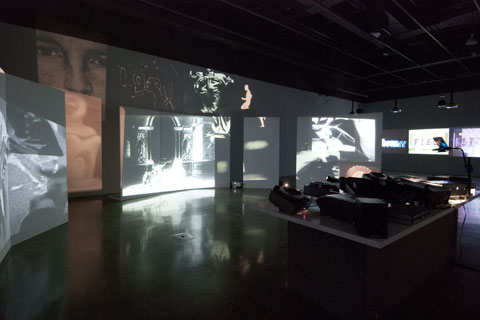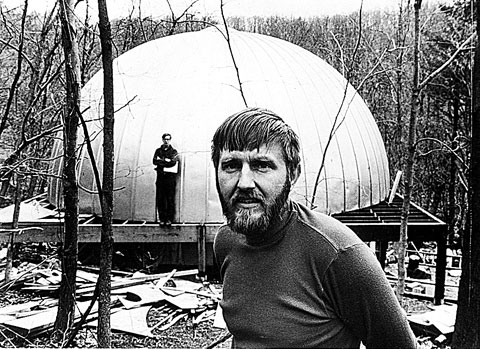
IN FRONT OF THE MOVIE-DROME (1965) VanDerBeek’s techie media experiments were an activist, politicized version of Timothy Leary’s LSD-drenched bacchanals. |
In April 1966, sheriff's deputies were hiding in bushes, peering into a mansion that had been turned into a headquarters and commune for LSD guru Timothy Leary and his pals at Millbrook, New York. The nighttime raid turned up only a small amount of marijuana, and the officers failed to make charges stick in court. But note what they spied through the windows.
"Guests splashed blobs of colored paint on the mansion walls. Chromatic patterns undulated. Men with longish hair tended to a roaring fire while beautiful women danced about with yogic grace," Don Lattin reports in his 2010 book The Harvard Psychedelic Club. "Movies were shown of cascading waterfalls, kids jumping on trampolines in slow motion, men jumping out of airplanes, and other scenes designed to heighten the psychedelic experience."
It's just a coincidence, but note the similarities between the films Leary's gang were watching and a series of kaleidoscoping, punch-card computer-animated films that underground filmmaker Stan VanDerBeek began creating with programmer Ken Knowlton of Bell Telephone Laboratories in New Jersey in 1964. Their Poemfield No. 5 (1967) flashes numbers and the pixelated words "free fall" over footage of a spinning skydiver hurtling toward the ground below.
>> SLIDESHOW: "Stan VanDerBeek: The Culture Intercom" at the MIT List Visual Arts Center <<
"We're just fooling around on the outer edges of our own sensibilities," VanDerBeek explained in Gene Youngblood's 1970 book Expanded Cinema. "The new technologies will open higher levels of psychic communication and neurological referencing."
As with the experimental trips Leary conducted with psychedelic drugs through Harvard University from 1960 to '63, the goal of many Age of Aquarius experimental filmmakers was a new human consciousness. VanDerBeek (1927–1984) shared these utopian aims, but his goal wasn't simply an interior journey for the audience — it was an urgent effort to bond people as a way of staving off nuclear war. "We must somehow find a way to talk to each other, to talk to ourselves and understand ourselves," he said in 1967. "The problem about the future is that we may not get into the future. . . . Artists haven't got the privilege of going off to their ivory towers and isolating themselves."
VanDerBeek is now the subject of a sharp retrospective, "Stan VanDerBeek: The Culture Intercom" at the MIT List Visual Arts Center. It's organized by Bill Arning, director of the Houston Contemporary Arts Museum, and List curator João Ribas.

TRIPPING The List’s re-creation of VanDerBeek’s 1968 Movie Mural is a strange, immersive, overwhelming, channel-surfing montage. |
You can trace VanDerBeek's style of collage, simultaneity, and interactivity to his studies at Black Mountain College, the artistic mecca in North Carolina, from 1949 to '51 and then his work on the '50s CBS kids' TV show Winky Dink and You, which encouraged viewers to order a clear vinyl mat to stick to their TV screens and then draw onto the program along with the show's host.